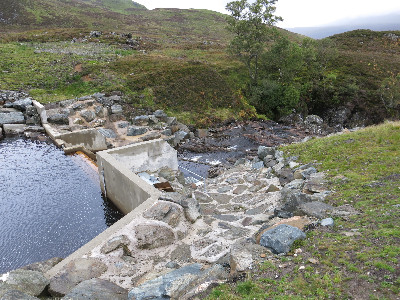
In an area identified for landscape or wild land qualities, or where there is an identified mountaineering interest that would be affected, we would normally expect hydro schemes to have the minimal impact on the landscape.
Where proposals are located just outside of a designated landscape area, we would expect an assessment of potential impacts on landscape character and visual amenity of the designated landscape. The visual effect of developments on the periphery of the boundary may affect the baseline characteristics of the scenic or wild land qualities of the designated area. Wild land is a finite resource and if the qualities are reduced it may take decades to recover.
Environmental statements would consider not only viewpoints from popular hilltops but also from walking routes. This would include assessment of visibility from the route through the landscape. The length of time the project is in view is an important consideration for hillwalkers.
We accept that construction of the intake weir requires temporary tracks to be built. We expect to see stated in the proposal that contractors will follow the SNH/SEPA guidance, Hydroelectric Schemes and the Natural Heritage, and that track management and restoration will follow the SNH guidance Constructed Tracks in the Scottish Uplands.
Construction stone would be local material, won from existing nearby quarries or borrow pits if possible. New quarrying would be designed to fit with the landscape. Turf cutting and storage would follow best practice guidance.
All hydropower proposals would require an Environmental Clerk of Works to oversee construction and restoration, including ground preparation work. In designated landscape areas a Landscape Clerk of Works would be employed from the start to oversee route design, ground preparation and soil storage, and the restoration of tracks post-construction.
Infrastructure would be designed to blend in with the landscape. Intake weirs would be low in height with essential fittings of a scale and finish that fits an upland landscape. The facings finished with local materials such as boulders or cobbles and turves, not bare concrete blocks.
All structures not faced with local materials would be painted to help them blend in with the surrounding ground cover (exposed pipe, valves, railings). Culvert piping would be cut flush or if not possible then local stone used to hide it. All surplus building materials would be removed.
Powerhouses would be buried or mounded to blend with the landform. If there are existing buildings present, then the powerhouse finish would be of sympathetic design.
In National Parks, National Scenic Areas and Wild Land Areas we would expect to see no new permanent tracks, although paths for intake maintenance are acceptable, of a standard for a walker/stalker or by quad bike if necessary. In other parts of the uplands a maintenance access track of 1.5m width would be acceptable. Where a wider track is proposed, detailed reasons must be given to justify it. Only in extraordinary circumstances would we find it acceptable.
If there are existing tracks present, they would be used in preference to new tracks being constructed. Short spurs of new construction may be required to intake and powerhouse locations. After construction tracks would be reduced in width to 1.5m or less for maintenance access.
Track and penstock restoration work would commence as soon as practicable. Penstocks would be excavated and restored in phases to reduce erosion potential. Maintenance tracks are best built separately from the penstock route, following contours to blend into the landscape.
All construction tracks would be reduced to a clearly defined specification. Good practice would dictate that restoration is laid out in an Environmental Report providing clear and unambiguous detail on how this will be achieved. This would include penstock restoration. Undefined phrases such as “restored to a track suitable for use by 4x4 vehicles” are not acceptable in planning terms.
Approved by Board of Directors
25 November 2018
Since our foundation as the Mountaineering Council of Scotland over 40 years ago, Mountaineering Scotland has been representing the views and needs of hill walkers, mountaineers, climbers and snowsports tourers. We work closely with our members, the media, partner organisations, the government and landowners to make a real difference on the matters that affect us all.
By becoming a member of Mountaineering Scotland, you are supporting this work and adding your voice to that of 14,000 other members by getting involved in our campaigns to protect access rights and encourage sustainable mountain environments.